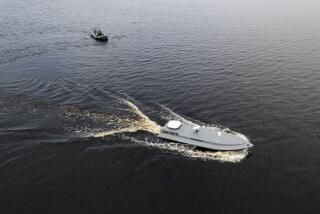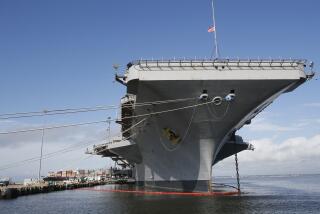Soviet Military Planning to Cut Fleet by 20% to 25% : Armed forces: Navy chief says that better-quality vessels will result in no loss of defensive capability.
- Share via
MOSCOW — The commander in chief of the Soviet navy announced Thursday that the number of vessels in his country’s fleet will be cut by between 20% and 25% within the next decade, the official Tass news agency reported.
Adm. Vladimir N. Chernavin, however, said that the Soviet fleet--one of the world’s largest--will maintain defensive sufficiency despite the cuts.
“Combat capabilities of the navy will be maintained thanks to the qualitative renewal of all branches of the service,” Chernavin told Tass.
The announcement of planned naval cuts came during a visit to the Soviet Union by Gen. Colin L. Powell, the chairman of the U.S. Joint Chiefs of Staff, who praised recent cuts in the Soviet armed forces and the planned reductions of the United States and Soviet Union’s nuclear arsenals.
Western diplomats in Moscow said the naval cuts probably reflect a decision to decommission old, worn-out ships and reshape the Soviet fleet to emphasize quality instead of quantity.
Chernavin said that the latest Soviet ships, particularly the Typhoon-class guided missile submarines, the third-generation attack submarines, the Kirov-class cruisers and new Sovremenny-class destroyers, will form the basis of the country’s restructured fleet.
In the last few years, the Soviet navy has been reducing its overseas presence as part of the nation’s new military strategy, which aims at de-emphasizing offensive capabilities while maintaining defensive stability, according to the U.S. Defense Department’s annual survey “Soviet Military Power.”
Adm. Sergei G. Gorshkov, who directed the navy’s expansion in the 1960s and 1970s, justified the buildup as necessary for the Soviet Union to compete with the U.S. fleet in the world’s waterways and to protect its interests and those of other socialist countries.
For the last three years, the Soviet Union has been pushing for navies to be included in Soviet-American and multilateral arms reduction negotiations and has been decommissioning some of its old ships each year in goodwill gestures directed toward its neighbors in Europe and Asia.
The United States has so far refused to include naval forces in arms reduction talks, contending that America’s economy requires a strong navy to protect shipping lanes. The Soviet economy, by contrast, depends largely on land transport.
The planned unilateral naval cut announced by Chernavin could be an attempt to put naval arms reductions on the international agenda, just as President Mikhail S. Gorbachev’s unilateral, 500,000-troop reduction two years ago sped the conclusion of the agreement between the North Atlantic Treaty Organization and the Warsaw Pact reducing conventional armed forces in Europe.
During a news conference Thursday, Powell and his Soviet counterpart, Gen. Mikhail A. Moiseyev, praised the bilateral reductions of nuclear weapons envisioned in the treaty on strategic arms that Gorbachev and President Bush are scheduled to sign here next week during their summit meeting.
BACKGROUND
During the 1960s and 1970s, under the direction of Adm. Sergei G. Gorshkov, the Soviet navy expanded dramatically from a relatively small, largely coastal fleet to a massive fighting force, with ships off its Pacific Coast, both coasts of the United States, in the Indian Ocean, in the Baltic Sea and in many northern waters. According to the authoritative, London-based International Institute for Strategic Studies, the Soviet navy in 1990 had 323 submarines, 227 principal surface ships, 395 patrol and coastal combat vessels, 331 mine warfare ships and 77 amphibious craft.
More to Read
Sign up for Essential California
The most important California stories and recommendations in your inbox every morning.
You may occasionally receive promotional content from the Los Angeles Times.













